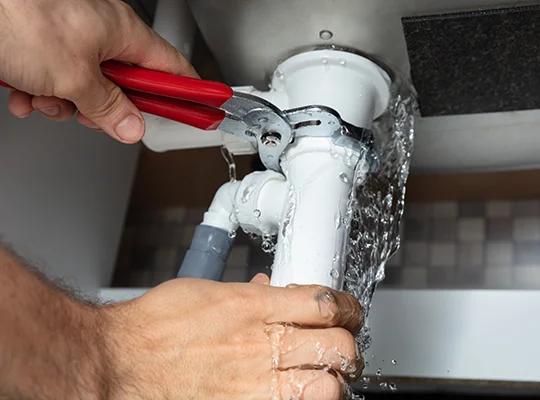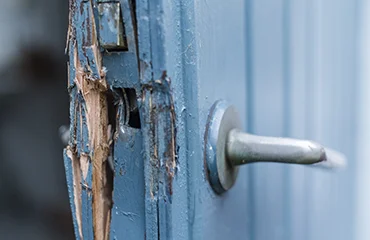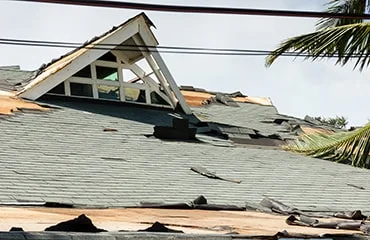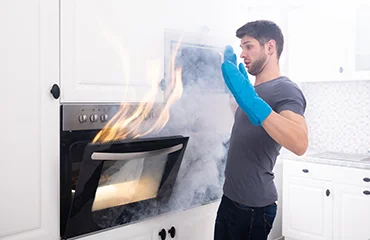Water damage can happen suddenly without notice to your home or business. An unexpected burst pipe or plumbing fixture can result in extensive damage throughout your home or dwelling. Water travels along the easiest paths, including inside walls. Water damage may be hidden in different areas of your home or business. Water wicks up walls including within insulation to furring strips and beyond. If not intervened, water will cause mold and fungi potentially resulting in loss of equity in your home; and worse: health issues. Water will cause mold to grow, wood panels to expand, doorways to swell, and floors to buckle. Gulf Coast Public Adjusters will determine exactly where the water has journeyed, whether hidden or clearly visible.
Plumbing Leaks and Water Damage
Plumbing Leaks and Water Damage

Insurance companies will limit their scope to only obviously noticeable surface damages. While insurance coverage may exclude flooding or sewage backup, a homeowner’s or business policy should cover sudden perils such as a burst water pipe. Insurance policies usually protect and cover you forwater damage to walls and floors if the water originates from inside the property or plumbing system. Weather-related events like storms causing water damage should also be covered under your policy. Water leaks can happen at any time. Water saturates into your home causing pervasive damage to flooring wood materials, drywall, carpets, cabinets and more. Water claims can be triggered by distinct sources in your home such as appliance leaks originating from refrigerators, dishwashers, garbage disposals,or filtration systems. These water claims are usually a covered cause of loss in the average homeowner’s policy. Lately, policies have been setting limitations to water loss claims on water mitigation efforts and repairs (to as little as $10,000.00 per incident). Gulf Coast Public Adjusters will review your policy to ensure your insurance carrier is complying with your policy and pays you what you deserve to fully recover from your water damages.
Preventing water damage in your home or business
Water damage is one of the primary causes of property damage and is responsible for a considerable number of insurance claims. Check to be sure your insurance policy has adequate water damage coverage. If you are not sure of your coverage, contact your local insurance agent or Gulf Coast Public Adjusters to review your policy for coverage. The Institute for Business and Home Safety (IBHS) (http://www.disastersafety.org/) conducted research isolating 8 to 10 origins where proper safeguarding and appropriate maintenance may assist a property owner in avoiding and suffering water loss.
The major origins of water damages are:
- Toilets
- Washing Machines
- Water Heaters
- Plumbing Supply and Drain Systems
- Refrigerator Ice and Water Lines
- Sinks
- Shower Stalls
Toilets
Water damage from toilets costs anywhere from $2,000.00 to $10,000.00 per incident. Seventy-eight percent (78%) of incidents were caused by faulty supply lines, toilet flanges, fill valve assemblies or toilets that backed up and overflowed.
- After flushing your toilet, remain close to ensure the fill valve has finished refilling the bowl.
- If your tank or bowl overflows, turn off the water supply line (typically positioned beneath the tank in the rear).
- Create a routine of checking the flushing apparatus every three (3) months.
- The fill regulator is supposed to shut off once the float reaches the correct water level.
- Change the flapper or fill valve assembly should you detect sporadic or continuous tank refilling when the toilet is not in use.
- Examine the supply line every six (6) months.
- Make certain the connection to the valve is tight.
- Work the valve to ensure the water supply shuts off; replace it if necessary.
Washing machines
Ruptured water supply lines are the foremost cause of half of the washing machine water damage episodes. The typical cost of damage is $6000.00.
- When not utilizing, close the water supply valves.
- Replace old valves with lever-type valves that are easy to maneuver.
- Do not operate the washer machine when no one is at home.
- Ensure the water hose is not kinked; leave three to four inches between the machine and the wall.
- Check the water supply line hose every three months.
- Ensure all water and valve connections are secure, but do not over tighten. Hand tighten first, and then utilize pliers if necessary.
- Examine the hose for cracks, blisters, or kinks.
- Change the hoses on a regular basis and consider reinforced braided stainless-steel hoses.
Water heaters
The probability a water heater will burst, leak, or break down is significantly increased after five (5) years. Three-quarters of all water heaters fail before they are twelve (12) years old.
- Have a professional plumber inspect the anode rod at least once every two years and annually once the warranty has expired. The rod will eventually corrode and leave the tank vulnerable to damage.
- Eliminate sediment by flushing the tank every six months. Sediment will build up quicker in areas where there is hard water.
- Verify the life span date on the unit where the model and serial numbers are located. Replace the unit if needed.
Plumbing supply and drain systems
Homes thirty (30) years old were three times as likely to have plumbing supply or drain issues. Homes in the South, where plumbing is typically beneath the slab, were twice as likely as their Northern neighbors to have supply system problems.
- Visually inspect plumbing pipes every six months looking for condensation around pipes or obvious leaks and/or corrosion.
- Pay attention to your water bill. A significant increase in usage may indicate a water leak.
- Call a plumber at the first signs of rust-colored water, backed-up toilets, or sinks, and cracked or warped flooring.
- Pipes in attics, basements and exposed exterior pipes should be insulated to avoid freezing.
- Open cabinet doors to allow pipes to warm air during freezing weather.
- Disconnect garden hoses when freeze warnings are issued and disconnect hoses when tropical storms or hurricanes warnings are issued.
Refrigerator and icemakers
Seventy-three percent (73%) of water damages involving a refrigerator icemaker were caused by the failure of the supply line hose. Ten percent (10%) of episodes involved new refrigerators and were associated with improper installation.
- Correct installation of the icemaker supply line hose is essential to circumventing water damage.
- Tightly connect the hose to the valve, but avoid over-tightening.
- Inspect the hose every six months. Ensure the valve connection is secure and check for kinks.
- If kinks are present, replace the hose.
- Leave a 3-to-4-inch space between the back of the refrigerator and the wall to prevent the hose from crimping.
- Prevent getting the hose caught under the wheel when taking the refrigerator out for cleaning or service.
- Locate the water shut-off valve.
- Every six months or so inspect the valve to make sure the water supply will shut off. Replace the valve if needed.
Sinks
Water damage from sinks averaged more than $7,000.00 per incident. Forty-four percent (44%) of these incidents were attributed to defective plumbing supply lines.- Inspect plumbing under sinks every six months.
- Make sure connections are tight and there is no indication of corrosion on the pipes.
- Check for kinks in copper or plastic pipes. Kinks may develop over time to pinhole leaks.
- Locate all water shut-off valves inside of the house, as well as the main shut-off typically located on the outside of the residence.
- Replace the valves if necessary.
Shower stalls and drain systems
Residences over twenty (20) years old were 37% more likely to suffer water damage involving a shower. Over half of the shower stall water damage occurrences involved a faulty shower pan.
- Test the shower pan by blocking the floor drain.
- Blocking the floor drain.
- Fill the shower stall with about one inch of water.
- Mark the water line.
- Leave the water standing for eight (8) hours.
- If the water level decreases, contact a plumbing professional.
- Inspect the tile and grout on a regular basis, paying close attention to loose or cracked tile or grout.
Homes builders that provided Roman tubs or showers in which one stepped down into the shower (usually below the main floor level) omitted shower pans. Thus, those homes suffered water damage that went undetected in adjacent rooms.
Roof leakage
Roof leakage is one of the leading causes of water damage in a residence or business. The possibility of a roof leak is even more prevalent in areas where freezing weather, harsh wind or hail often occurs.
- Have a licensed qualified roofer look over your roof annually.
- Ask for an all-inclusive inspection report that contains the state of the flashing, roof covering, parapets, and drainage system.
- Perform repairs if there are indications of fractured, missing shingles or tiles, and loose or missing granules. If the flashing is deteriorating, particularly around skylights, chimneys, and vents; or if pooling water is present.
- Look for plant growth as signs of sitting water and possible wear and tear.
- In areas vulnerable to freezing and heavy snow, insulate to avoid the elements from entering the attic space.
- In regions susceptible to wind and hail, consider an impact-resistant roof covering that has passed the FM 4473 or UL2218 standards.
In the event your home or business has suffered any water damage be sure to contact Gulf Coast Public Adjusters (before you contact your insurance company). We will represent you through the entire insurance claims process.



